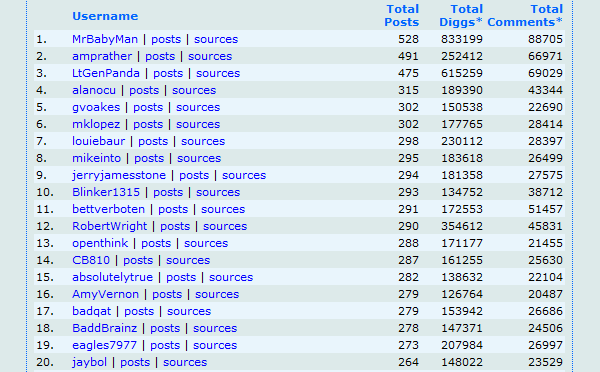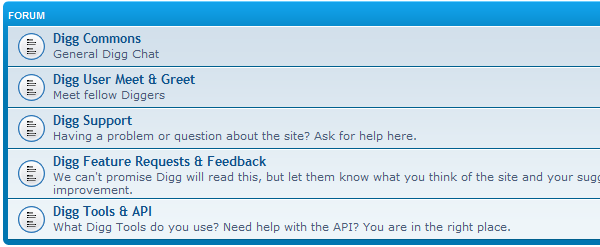Digg’s V4 redesign was more than a change in look and feel. It was a complete shift in the direction of the company that was intended to take it to the next level. It was a risk as admitted by former CEO Kevin Rose. So far, the risk has not paid off and “the next level” is a level below where they were with V3 (and even V2).
For Digg to achieve the success they desire, they have to make a few changes.
Many things have already changed. Installing a variation of the Upcoming section that had been removed was a start. They brought back the user submissions page, then populated archived submissions. Pagination is improved – not perfect but better. The site seems to be crashing less and less.
It’s a good start. Here are some changes that need to be implemented to keep Digg on the road to recovery and eventually increased success.
Bring Back the Bury Button
The “hide” button isn’t effective for keeping off spam (from what we’ve seen so far) and the “report” feature, while apparently improved from the spam fest of 2 weeks ago, still requires a moderator to be on the ball 24/7. There are many valid reasons to not have a bury button, including organized burying, but must be a way to make it work.
Some have suggested limiting the number of buries a user can put in, even down to 1 a day. Others have suggested having the bury feature reversible by a moderator so that all stories that get buried can be “revived” if it is deemed that the content was good enough quality but someone or some group attacked it unfairly.
Either way, something needs to happen. Kevin Rose tweeted a poll regarding the button and nearly 70% responded that it should come back. Even in politics, this is considered a supermajority. The people have spoken.
Limit (Or Eliminate) RSS Submissions
The biggest and most controversial change that Digg made was the attempt to switch focus on the site away from human submitters and turn the reins over to publishers. Websites were to become the new “power users” without doing a thing – just publish the content and Digg would feed them on their way to social media success.
At first, it didn’t work. Then, it worked too well. Now, it seems that things have naturalized a bit but it’s still a huge failure compared to what it was supposed to do.
Before offering the solution, let’s take a brief look at why it failed. The short answer is “bad math”. Close to the end of V3, top power users such as MrBabyMan and LtGenPanda were able to get 200, 300, even 400 Diggs on their submissions before even hitting the front page. MrBabyMan has over 18,000 followers – the most of any human user other than Kevin Rose – so applying basic math, Digg assumed that once they changed over to V4, users like Mashable and NYTimes would be able to get close to to the same amount of Diggs since they had more friends.
The initial threshold to become popular was set at 200. After the first day when only carryover stories from V3 were hitting this number, Digg likely started to worry but probably assumed that people were just shell-shocked by the change. Day 2 didn’t change anything, and again only older stories were being promote.
By Day 3 when very few of the publishers stories were getting many Diggs and the 48-hour time-limit to hit was about to pass for the old stories, Digg panicked. Just a little. They started driving the threshold down. They continued to drive it down until publisher stories were able to hit. For several days, nothing but publisher stories were able to hit. Most would hit in the 30s. Some would hit in the 20s. Mashable, Reddit, Engadget, and Leo Laporte dominated the front page because they had more followers who were actual Digg users.
The “solution” that Digg came up with was to open the front page up to normal user submissions and move the threshold up or down depending on traffic levels. That brings us to today, and to one solution regarding the feeds…
Publishers are able to auto-submit dozens, even hundreds of stories at a time. They can then have a second (or more) accounts that also follow the same feed and automatically Digg every story that they submit. As a result, the Upcoming Recent section of the site is often worthless with pages and pages of utter spam to filter through at any given time.
Initially, Digg (before it knew the reaction of the community to auto-fed submissions) asked publishers to submit a lot: 5-20 a day. To correct this mistake, they should limit the subs to 5 per day, max (or eliminate auto-fed submissions altogether). They should ask publishers to create a Digg-only feed where only the best stories are submitted.
Publishers will also need to be encouraged to participate outside of their feed. Commenting, Digging other stories, and becoming more “natural” Digg users may be the only way to salvage this aspect of the site.
The biggest challenge is asking publishers to get involved. Many, particularly the bigger ones that Digg covets, will be unwilling to jump through hoops for Digg’s sake. Some have already noted a major decline in Digg as a referrer to their site. To ask them to be “good Digg users” now will be difficult. Having major publishers submit less, Digg more of other users’ content, and comment is going to require more than an email or a phone call. It will take…
Training and Integration
Let’s assume that Digg will never return to user-only submissions. They have too much invested into becoming the Twitter of social news to abandon the concept altogether (yet). If they must continue down this path, they will need to establish the site as a relevant and necessary component of any publication’s social media strategy.
Just about every major website has someone working Facebook and Twitter. Whether it’s the site owner, an intern, or a community manager, most websites and companies realize that setting and forgetting social media is ineffective.
Digg has not made that leap to be more than just a traffic-driving source. Hitting the front page is a mystery to 99% of those who use the site regularly, so why should Digg expect publishers to fair better?
They can’t (or won’t).
Digg should offer training on how and why to use Digg as a part of the daily routine for the social media person at any publication or company. The community is robust enough and controls a niche that isn’t easily touched by Facebook and Twitter, and as a result should get some respect. With the right training on why and how, Digg can turn many publishers into successful and engaging users, which will in turn encourage more of them to take Digg seriously.
Giving them a feed and throwing them to the wolves (and Digg wolves have sharp teeth) is a recipe for disaster.
Make MyNews More Relevant
The concept of the MyNews section (which is the default homepage for those logged in) was interesting. It quickly became useless for many as those who may be quality submitters turned into people that you couldn’t follow if they Dugg too much. What a user Diggs would seem less important than what they submit or comment on.
People Digg things for different reasons, but they submit because they feel that the content is good and they comment because they had an opinion they wanted expressed. It’s the content that people we follow feel strongly about – their submissions and their comments – that would make more sense to include in the MyNews page.
It would also be nice to include keywords as an option to include in MyNews. People may want to hear everything they can about the iPad or Nancy Pelosi or Iran, for example, and would like that included in their news section.
Statistics, Leaderboards, Insights… Even (gulp) Badges
I’ve never understood why Digg is so guarded about data. They have it all but won’t share it with anyone. Being able to look at numbers such as how many subs by a particular user or website hit the front page, how many Diggs they get, how many clicks they had – many on Digg would love to see this data.
For years, Digg users would have to visit other sites to see how they were doing. This is simply silly and the ills that forced Digg to go dark years ago are likely a non-issue today.
Comments are another aspect that Digg should track. Some people live in the comment threads rather than through submissions. Being able to see total points on all comments by a userwould encourage wit, humor, thoughtfulness, and even an occasional troll to be more engaged.
Finally, as much as it pains me to say so, badges or other types of “rewards” for quality activity would benefit the users. Some of them. I personally have never understood the appeal, but it works on other sites. Having “achievements” similar to those found in many games can bring an element of fun and encourage activity beyond simply scanning the top news section for the latest Infographic.
A Forum
Talk to us. Let us talk to you. Feedback channels are weak.
‘Nuf said.
Not Shouts, But… Something
Digg is a social media site. It’s one of the only social media sites that does not encourage any form of communication between users other than in the comment threads.
Shouts failed. Some loved them, some hated them, but they weren’t really the right solution. Still, there should be some way to communicate with a user other than in the comments section or by hoping they post their IM on their profile. While I would detest having a “wall” or anything like that, allowing users to communicate with their mutual friends just makes sense.
For a social site.
Like Digg.









Do you think the resulting loss in traffic at Digg’s website could have been prevented had they taken a similar approach to the Gap and listened to the complaints found on every social media medium? I talk about this at my blog, and would love to hear your thoughts!